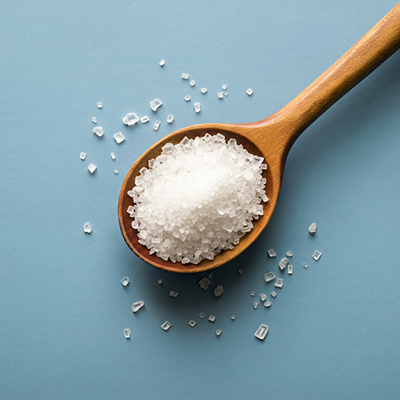Contents

Sodium (Na) works closely with potassium and chlorine in a number of important functions. They maintain proper electrolyte balance; for they change into electrically charged ions which carry nerve impulses. They also control and maintain osmotic pressure into, and out of, the cells. This enables the blood to carry nutrients throughout the body. They also keep the amount of body fluid at the proper level. Sodium is an important constituent of stomach acid.
Sodium Sources
Although it is found in a variety of foods, including romaine lettuce, celery, asparagus, and watermelon, most people like to get it out of the saltshaker. The best source of added salt to your diet is Nova Scotia dulse or Norwegian kelp. Both are full of vitally needed trace minerals.
Deficiency Symptoms
It is rare for a person to have a sodium deficiency. But it may be caused by excessive sweating, chronic diarrhea, or overuse of diuretics. Muscular weakness, heat exhaustion, mental apathy, nausea, or respiratory failure can result.
- Excess symptoms – Too much sodium in the diet is far more common, and is shown in water retention, high blood pressure, stomach ulcers or cancer, hardening of the arteries, and heart disease.
Needed for Assimilation
- Vitamin D
- Calcium
- Potassium
- Sulfur
The Salt Problem

Sodium is a mineral you should be very cautious about. You need a little, but only a very little. In America, only 5 percent of the sodium comes from natural food. Prepared foods add 45 percent, cooking adds 45 percent more, and condiments add another 5 percent. All the sodium the body generally needs is found in the natural (unsalted) food which is eaten.
- A word about table salt: Most of it has added aluminum; to keep the salt free flowing, you do not want to eat aluminum (Alzheimer’s is not easy to live with)! So-called “sea salt” is just regular salt; it has no other minerals in it. If the salt you buy is free flowing, you do not want to use it (because of the added aluminum)! But, if you insist on buying regular salt, select iodized salt. Because Americans add too much salt to their meals, they have a potassium-to-sodium ratio of 1:2. (They are eating twice as much sodium as potassium). What is needed is a 5:1 ratio (five times as much potassium as sodium) to maintain good health. If you eat a natural diet of fruits and vegetables, you will take in 100:1—100 times as much potassium as sodium. If you will look on any food chart, you will find that all the natural foods have a high potassium to sodium ratio, whereas all the junk food will have a high sodium to potassium ratio. Do not be afraid of potassium; you cannot get too much! Do be afraid of excess sodium.
Dosage
RDA 1100 mg / ODA 200-600 mg / TDA 300-3000 mg. Sodium is a mineral to avoid. You need little, but not very much. If you want to get it from the saltshaker, sprinkle a tiny (tiny) bit on only one or two foods at the table, having put none in the cooking.
- Recommended: Obtain sodium from natural food alone, plus, at the most, only an extremely slight amount of table salt. The best way to do this is to pour a tiny amount into your hand, so you know you only have a very small amount; then pour it onto your food. (If you pour salt directly on your food, you cannot see how much is going on it.)
HEALTH DISCLAIMER: The information on this website is for educational uses only and is not a substitute for professional medical advice. Always consult an authorized healthcare provider for any health concerns before using any herbal or natural remedy. We do not establish, treat, cure, or prevent any disease. Reliance on any material from this website is solely at your own risk. We are not responsible for any adverse effects resulting from the use of information or products mentioned on this website.
REFERENCES
Vance Ferrell, Harold M. Cherne, M.D. 2010. The Natural Remedies Encyclopedia. Altamont : Harvestime Books, 2010. pp. 112. Vol. Seventh.
